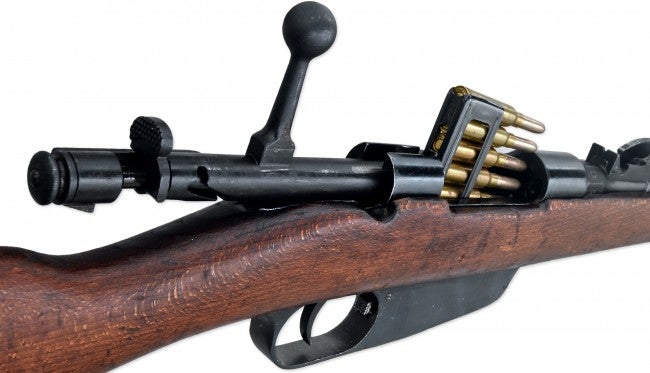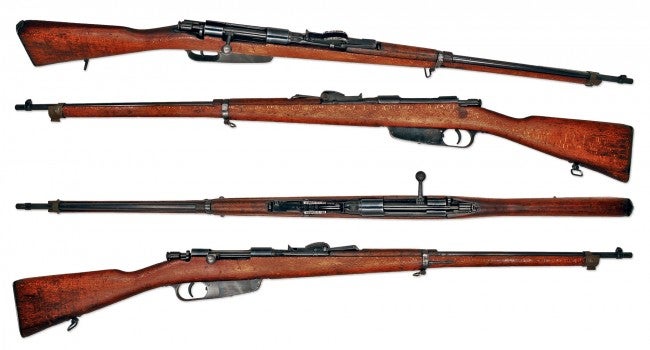The Carcano rifle often evokes only two reactions in people. First, most remember the Kennedy Assassination. This is usually followed by a murmuring of how Oswald could have done the deed with such a sloppy, inaccurate, unreliable, rifle that has just as much a chance as blowing up in your face as firing properly.
While we did lose a president to a Carcano M38 short rifle, the rest is apparently a 50 year old game of telephone. A letter to the editor in a national gun journal during the post war years made claim to a Carcano rifle simply blowing up and ejecting it’s bolt into the shooter’s face. It warned that these guns should not be trusted and were made to inferior standards. The story has never been confirmed and we’ve yet to see a documented failure with factory ammo, but the rumor keeps spreading down through the generations.
So let’s start over and do a very brief recap of the Carcano at the time of its adoption:
The Model 1891 Carcano was adopted as a long rifle in the 6.5x52mm smokeless, centerfire cartridge. At the time, it was the first 6.5mm bullet in standard service. Benefits included lighter carry weight, better penetration at long range, less recoil, and flatter trajectory resulting in a longer point-blank distance. Japan, The Netherlands, Romania, Portugal, Sweden, Norway, and Greece followed with their own cartridges later.
The Carcano action is often written off as a weird copy of the Gewehr 1888 but it includes more than a few differences. But first, yes, it does have a Mannlicher magazine licensed from Steyr in Austria. This means a bidirectional enbloc clip with six cartridges was loaded whole into the magazine and when the last round was pressed into the chamber the clip would fall free from a hole in the bottom. While the Italians were offered the additional rights to just produce a copy of the entire Steyr-Mannlicher rifle, they opted to use a better known native design by Salvatore Carcano.
In 1868 Carcano had designed a breech-loading conversion to refit the various obsolete muzzle-loading rifles in Italian service. This 1868 Carcano used bolt body with milled bolt head and a unique safety tab that essentially decocked the firing pin spring. Borrowing from the Gewehr 1888, the M1891 Carcano includes two forward locking lugs, cock-on-open milling on the bolt body, a tabbed cocking piece, and rear cap. Unlike the Gew.88, the Carcano’s bolt head was milled directly into the bolt body, it’s cocking piece’s guide rib seats in the left side of the receiver, and it features the unique “decocking” Carcano safety that interrupts the line of sight when on “safe”. It also uses a simplified bolt stop activated by the trigger and a single spring powers both the sear and a vertically set ejector under the bolt.

While none of this was truly revolutionary, the resulting action was as strong and capable as nearly infantry rifle of the day. Remember, Italy’s traditional enemy had been Austria and at this point they had only just hit on the Mannlicher M1890. Most of their army was still using wedge-locking Mannlicher 1888 and 1890 rifles with semi-smokeless cartridges of low pressure. The Germans were still using the Gewehr 1888, the French the Lebel. There was no Mauser 98 and the later schlegelmilch-improved Mannlichers had not appeared, heck the US had not even adopted the Krag-Jørgensen yet.
So what happened? Well, for the Italians at least, the Carcano might have been too good. There was never enough reason to spend their limited resources replacing these guns as the years went by. Additionally, early Carcano rifles were constructed with a secret gain twist rifling pattern that helped reduce wear on the barrels and so meant that they could remain in service longer and many were updated beginning in 1924 by simply being shortened into carbines. In 1938 an attempt was made to replace the aging 6.5mm cartridge, which was a greater problem than the action itself. The Carcano was adapted to the rather nice 7.35x51mm cartridge but by then war loomed and the logistics for a swap were nightmarish, so production was switched back to 6.5mm.
With the end of Italian involvement in the war, Carcano production stopped and the rifle disappeared from the inventories of major powers. Although it went on serving, like many other designs, in the surplus markets of smaller countries.
So, compared to other milsurps available in the current collectors market, does the Carcano stand out as a shooter? Well no, but neither do many other less disparaged designs. But, these rifles aren’t as dangerous or misguided as people assume. They are a fine collectable available in a number of configurations, often for rather low prices.
As always, we have a little extra on the M1891 Carcano over at C&Rsenal.
 Your Privacy Choices
Your Privacy Choices


